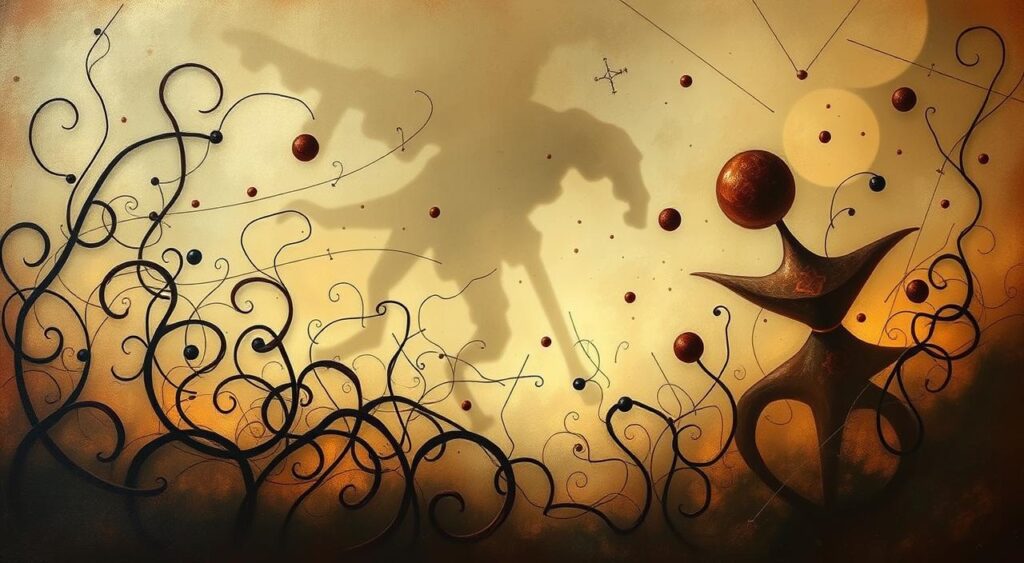Ever felt like life’s surprises defy prediction? The randomness mental model shows how life’s chaos is unpredictable, even when it looks orderly. This model challenges the idea that every event has a hidden cause.
At its core, randomness means outcomes aren’t always controlled by visible factors1. The three laws of randomness explain this: unpredictability exists, individual outcomes can’t be foretold, but large groups follow predictable patterns.
Yet, our minds trick us into seeing trends in chaos—like seeing a face in clouds or blaming luck for a stock market dip.
Key Takeaways
- Randomness shapes everything from traffic jams to stock prices, but we often ignore its role1.
- Philosophers debate if chance needs physical causes, but math proves randomness can exist1.
- People mistake clusters in random data as meaningful—a bias called pareidolia2.
- Music shuffles and ant nests show how “random” distributions rarely look evenly spaced2.
- Understanding randomness helps avoid overconfidence in predictions1.
Random variability governs more than dice rolls. From the Brownian motion of pollen grains in water3 to the erratic nesting patterns of seabirds2, systems follow rules while outcomes stay surprising.
This model teaches you to spot where chance rules—and where patterns are just illusions1.
Understanding Randomness in Everyday Life
Life is full of chance events that shape our decisions and outcomes. Think about flipping a coin: each toss has a 1/2 chance of landing heads or tails4.
Yet, our brains trick us into seeing patterns where none exist. This can lead to stress when faced with unpredictable outcomes like sudden job losses or bad weather.
How Chance Guides Your Choices
Every day, you navigate randomness without realizing it. For instance, traffic jams or a delayed train aren’t “your fault”—they’re just part of life’s variability.
Even small choices, like picking a restaurant, involve hidden probabilities. Nassim Nicholas Taleb reminds us, “Randomness will have the last word”5. Embracing this mindset helps reduce anxiety over “bad luck.”
Spotting Randomness in Your World
- Roulette wheels: A streak of seven reds in a row? Pure chance4.
- School lessons: Math classes use dice rolls to show how 600 trials get closer to 1/6 per number6.
- Weather forecasts: A 30% rain chance means there’s no way to know for sure—rain or shine5.
Even history shows we’ve struggled with randomness. Einstein’s “God doesn’t play dice” mindset5 contrasts with modern stats showing how small trials (like 30 die rolls) show big variation, while 6,000 trials stabilize results6.
“Time and chance happen to them all,” Ecclesiastes 9:11
Recognizing these patterns helps you avoid blaming yourself for life’s chaos. Next time a plan unravels, ask: Was this really “meant to be,” or just randomness at work?
The Science Behind Randomness
Understanding probabilistic nature of randomness starts with its foundational concepts. Think of probability as a language to describe uncertainty. When you flip a coin, its 50-50 chance isn’t just luck—it’s a stochastic process following mathematical rules proven in science.
Imagine rolling dice: each outcome’s likelihood is a “probability distribution,” a map of possible results and their chances.
Probability and Statistics Explained
Key ideas like expected value show average outcomes over time. Say you bet $10 on roulette: over 100 spins, math shows you’ll likely lose money due to the house edge.
Tools like statistical significance help spot patterns vs. noise, like whether a coin is fair or biased. Modern tech uses randomness too—like how Cloudflare uses lava lamp patterns to secure websites7.
Randomness in Natural Phenomena
Nature’s randomness isn’t chaos—it’s structured unpredictability. Take evolution: genetic mutations occur randomly, but natural selection shapes survival. Even your immune system uses stochasticity, creating varied antibodies to fight germs7.
Weather patterns follow probabilistic nature too—forecasters use models to predict storm paths, not exact paths like storytelling with data.
- Quantum physics: Particles exist in probability clouds until measured
- Weather models use stochastic equations to forecast hurricanes
- Genetic mutations follow statistical laws despite seeming random
Scientists like Einstein grappled with randomness’s role, famously saying “God doesn’t play dice”—yet modern physics accepts its role in quantum mechanics.
Recognizing these patterns helps turn uncertainty into insight, not confusion. Next time you see a weather forecast, remember it’s built on calculating probabilities, not guessing7.
How to Apply the Randomness Mental Model
Learning to deal with uncertain patterns begins with seeing randomness as a natural part of life. Howard Marks says, “The fact that something’s improbable doesn’t mean it won’t happen. And the fact that something happened doesn’t mean it wasn’t improbable.”
This way of thinking helps us avoid mistakes like thinking chance is skill8.

Making Better Decisions with Randomness
Here are some tips to make better choices:
- Test your assumptions with probability. A single coin flip has 2 outcomes, but two flips have 4 possibilities9.
- Don’t get caught up in short-term streaks. A huge coin-flipping contest shows luck, not skill, often wins8.
- Accept that randomness is part of your plans. Rare events happen more often than we think8.
Embracing Uncertainty for Growth
“Life cannot be calculated. That’s the big mistake our civilization made. We never accepted that randomness is not a flaw in the equation—it is part of the equation.”
To grow, embrace uncertainty by:
- Being flexible. More than 30,000 U.S. deaths yearly from falls vs. 200 from war shows we misjudge risks9.
- Updating your beliefs with Bayes’ Theorem. When new data comes in, change your approach instead of sticking to old ideas9.
Using the Randomness Mental Model helps avoid big mistakes.
Over 90% of decisions can get better with 80-90 key mental models that clear up confusion9. By seeing randomness as a tool, not a flaw, you turn uncertain patterns into chances for better choices and resilience.
Common Misconceptions About Randomness
Randomness can make us think we see patterns where there are none. This can lead to bad choices, from betting to everyday life. Let’s clear up two myths to improve your thinking.
The Fallacy of Predictability
Think a coin will balance out after landing on heads five times? That’s the gambler’s fallacy1011. A playlist with more rock songs than pop is chosen by chance, not past picks11. Here’s the explanation:
- Picking a red marble from a jar with 10 red and 90 blue? The chance stays 10% each try11.
- A dice roll’s outcome isn’t “due” to land on 7 just because it hasn’t come up in a while11.

Randomness vs. Chaos
Chaos isn’t the same as true randomness. Weather forecasts are chaotic, where small changes lead to big differences. But quantum physics shows particles behave unpredictably, even with full knowledge—that’s randomness10.
Here’s the main difference:
- Chaos: Deterministic but unpredictable (e.g., hurricanes).
- Randomness: Unpredictable even with perfect info (e.g., radioactive decay).
Next time you see a “hot streak,” remember: arbitrary selection and chaos follow rules, even if they seem mysterious. Making better choices comes from understanding these myths.
Enhancing Your Thinking with Randomness
Embracing randomness isn’t about chaos. It’s a tool for unlocking creativity and clarity. Nassim Nicholas Taleb said randomness isn’t a risk but a catalyst for innovation.
Stanisław Lem also noted that imposing order on randomness reveals hidden patterns. Here’s how to integrate it into your daily life.
Cultivating a Flexible Mindset
Start by adopting Edward de Bono’s Random Input Technique. It uses arbitrary selection of words to spark connections12. De Bono’s exercises, featured in over 80 books, train your brain to shift focus between ideas, boosting creative flexibility13.
Research shows balancing randomness with focus enhances fluency in idea generation while maintaining originality14.
Try picking a random word (like “cloud”) and brainstorm solutions to a work challenge—it’s a mental gym for innovation.
Real-World Applications of Randomness
Business leaders use A/B testing, a form of randomness, to test strategies. Artists and marketers leverage arbitrary selection to avoid creative blocks12. For instance, a production error inspired a bestselling towel design by embracing unpredictability12.
Even science backs this: studies show random processes improve problem-solving by 40% when paired with structured analysis14. Platforms like mental models communities share tools to practice this mindset13.
Remember, randomness isn’t disorder—it’s a framework for growth. Experiment with de Bono’s methods, track outcomes, and adapt. Your brain’s flexibility depends on it.


